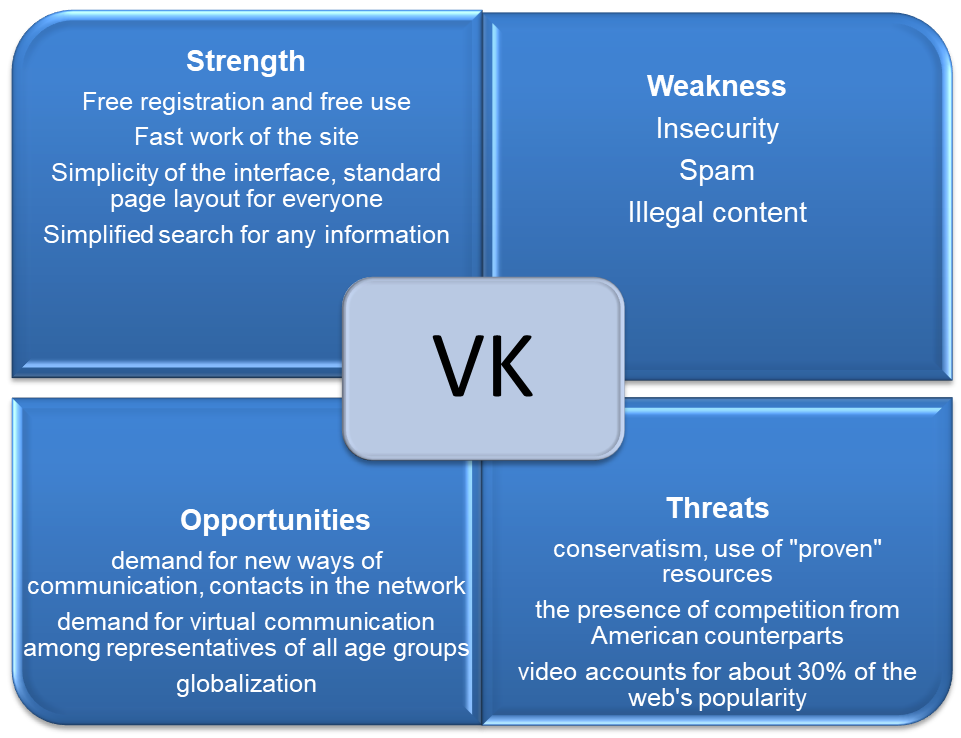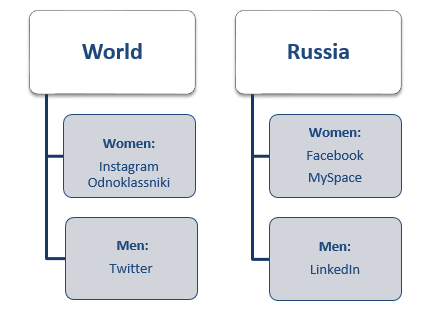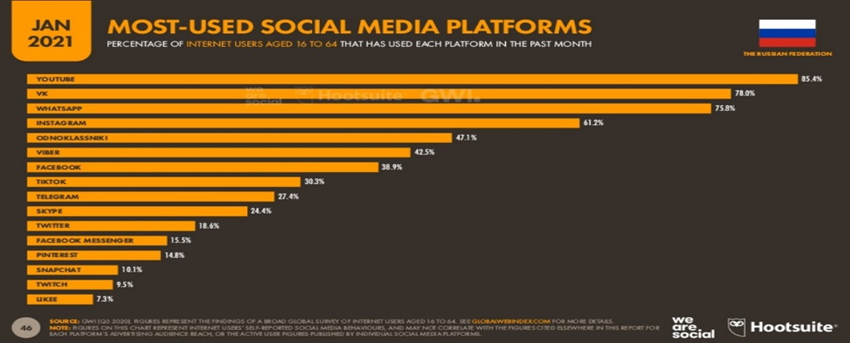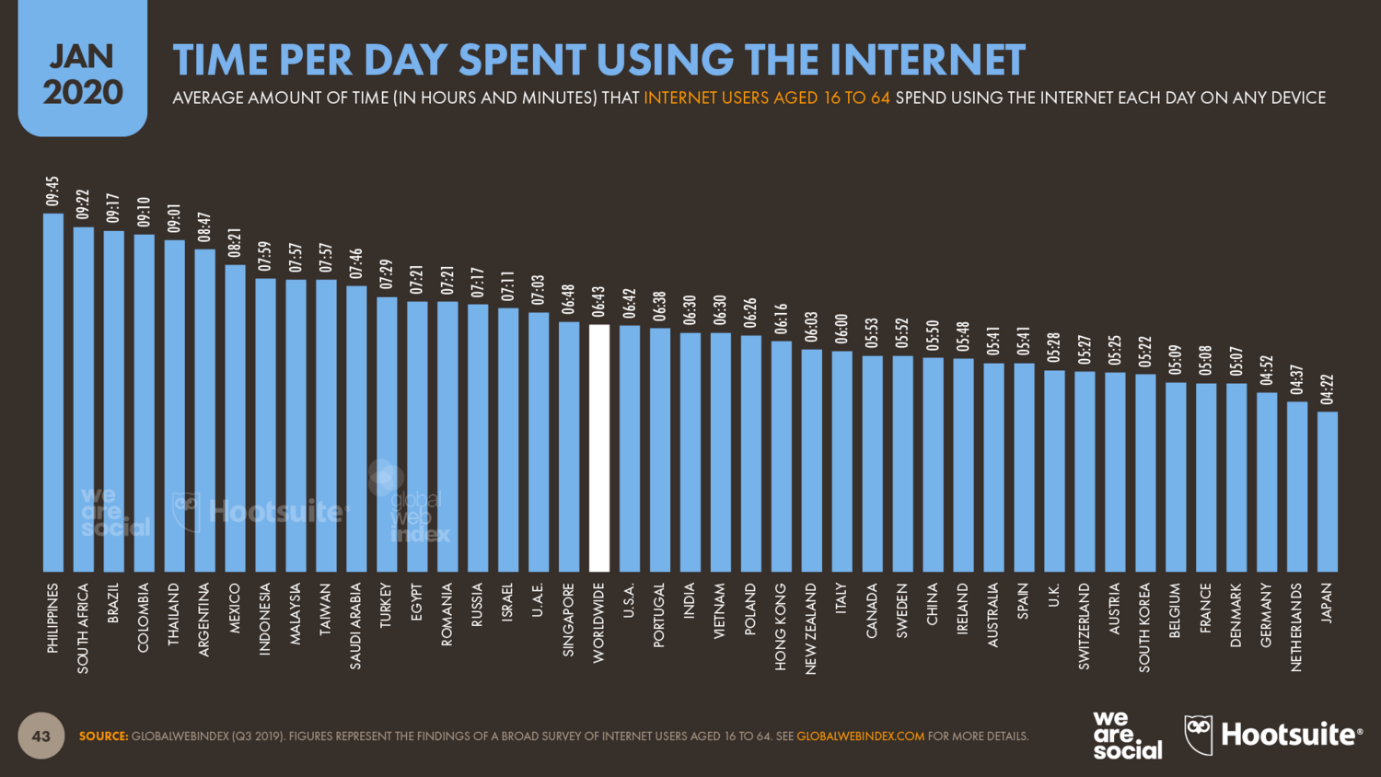The paper investigates the question of how the tendencies of Russian social media correspond to the world ones. Therefore, the study included such global social networks as Facebook, Instagram, and Twitter. At the same time, attention is paid to the effectiveness of social networks Vkontakte and Odnoklassniki in Russia because these are the central media at the national level. The comparison of trends was based on the demographic involvement of the world’s population and Russia in social networks. Moreover, the gender features of the use of certain media are indicated. The next trend was personalization, the value of which is to protect personal data. The essay considers economic indicators and information that is relevant for Russian and global users of social networks and their owners. Another critical stage of the analysis was the time allocated by residents of different countries to social systems. This trend of increasing the time of media use is relevant in the world and in Russia.
Therefore, the extended essay summarizes that Russia tends to make the most of national social networks, such as Vkontakte and Classmates. Although the preferences of users changed depending on the age of the population, Russian social media became the lead. As for making a profit from social networks, it is noted that most Russian users tried to use global social systems because of low profits from state ones. Thus, the Russian media do not always try to keep up with world trends, which leads to increasing involvement of Russian citizens in Facebook, Instagram, and Twitter.
Introduction
In 2021, the spread of social networks has become ubiquitous, global in nature, and their technological development allows not only these platforms to conduct business, but also brands and even individuals. The There are nearly four billion social media users worldwide, relating to almost 57 percent of the whole global community. The typical user actively visits an average of 6 different platforms and spends around two hours using social media each day. Considering that people sleep for between 7 and 8 hours per day, these data intimate that they waste approximately 15 percent of waking lives using social media. Collectively, the globe absorbs more than 10 billion hours each day, equivalent to nearly 1.2 million years of personal living. Social networks become that part of the daily routine without which it is impossible to imagine your life.
They have ceased to be only methods of communication, but become providers of services, news, financial transactions or trade. However, it should also be regarded that there are some variations in the application of media platforms around the world; the trends are different as well. Russian social media are characterized by greater differences than other countries. Therefore, it is important to establish how the indicators differ and whether this has a positive impact on the business environment and social media in general. In order to establish to what extent Russian social media, correspond to global trends, it is essential to study national trends and then make comparisons.
Global and National Social Networks
In Russia, as in other nations, the figure of Internet users is progressing. Russian communicative media users are also some of the most involved in the world. In general, internationalized popular networks as Facebook and Instagram occupy the top places in the world. In January 2021, the most popular social network globally, according to Statcounter Global Stats, was Facebook, whose share was 69.8%—followed by Pinterest (11.9%), Twitter (9.5%), YouTube (4.9%), and Instagram (2.6%) (Howard 2021, 1). Nevertheless, Russian corporations do not have the equivalent business share presented in Europe and the United States of America.
Instead, such media as VKontakte (VK) and Odnoklassniki are considerably popular and in demand in Russia. For example, 83% of the group use VK, and another domestic Russian media platform, Odnoklassniki (OK), is accepted by 55%. ‘The market part-owned by US-based social media systems is significantly lower. Facebook has a 39% share, while Twitter has a 19%’(Howard 2021, 1). According to a study by the Scientific and Technical Center of the Federal State Unitary Enterprise ‘Main Radio Frequency Center of Russia,’ along with residents of other countries, Russians are the least dependent on global Internet platforms. Facebook, Google search engine, Instagram, TikTok, YouTube, and Twitter were chosen as online platforms researchers evaluated.
For the study, the experts selected 24 countries with different populations, geographical locations, and levels of Internet penetration. Russia ranks second among the least dependent on global platforms in countries with a high share of Internet users (more than 75% of the population) ( GRF 2021). This is due to the availability of quality domestic Internet services. Expert circles in Russia discuss the possibility of blocking access to YouTube, Facebook, and Instagram in the country. Authorities call such versions delusional, while organizations working to protect Internet freedom see the threat as accurate. They are preparing a so-called phasing-out strategy, which should be completed by 2021. The strategy of gradual shutdown” of foreign social networks will be turned off not at once, but gradually. All this will be broadcast and actively discussed on TV and other media, after which access to foreign social media will be blocked.
Technical experts, with whom DW was able to speak on condition of anonymity, agree that blocking Western social media is possible, citing China, where Facebook, YouTube, and even Google have long been banned (Miller et al. 2016). At the same time, experts also point out that blocking will require significant efforts from the authorities, as it is much more challenging to block the most significant social networks than a regular site. In addition, they warn, it will seriously damage the Internet infrastructure as a whole.
The Russian media space is slowly moving towards making its own social networks the only monopolists on the market. As was mentioned earlier, the most popular among Russians is the social network VKontakte – it was used in December 2020 by 83% of all Russian Internet users (49% of the total population of the Russian Federation) ( GRF 2021). Vkontakte should become a national resource that dominates over global ones. Considering all the indicators, there is a real chance that such a plan will be implemented, but there are also threats. In order to better illustrate the idea, a swap analysis was conducted.

The Trend of Using Social Networks according to the Demographic Method
The trend is that the percentage of statistics is lower than in the United States, but Russian citizens adapt to social networks rather rapidly. According to Russian Search Marketing, 49 percent of Russia’s population (70 million people) are everyday users of social networks (Russian Search Marketing, n,d). In Russia, popular media outlets are VKontakte, Whatsapp, and Instagram, according to a Mediascope study. At the same time, in the United States of America, the center of the youth Twitter, and Instagram. The Russian Center for the Study of Public Opinion showed analysis data on Russians’ use of social networks. Research has shown that 45% of respondents over the age of 18 tend to use at least one social network daily, 62% – at least once a week (Russian Public Opinion Research Center, n,d). However, it is not a standard trend that almost a third of people do not use social networks (20% of them do not have access to social networks, and another 10% do not want to apply for an account).
The maximum level of involvement, as expected, turned out to be among young people – in the group of 18-24 years old, 91% use social networks almost regularly. Catching into account respondents aged 25-34, the rate of involvement in social networks was 69%, and in personalities of retirement age only 15 percent (Kaushal and Patwardhan 2018, 23). This Russian trend does not correspond to the world one since humans over the age of 60 in the developed world are active Internet users.
The VKontakte network has the most massive coverage in Russia – 28% stated about its daily visits, Odnoklassniki ranks second (19%), and Instagram places third (14%). The share of the regular audience on Google+ was 7%, Facebook and My World scored 4% each, Twitter and LiveJournal each 1%. VKontakte and Instagram grounded out to be the freshest platforms. The most substantial share of the public of VKontakte users – 40% – descends on people aged 25–34 years (Russian Public Opinion Research Center, n,d). Among Instagram users, 38% are between the ages of 18-24, 37% are among the ages of 25-34.
The daily audience of Odnoklassniki, the most extensive organization, includes 25-34 years old (28%). At the same time, the distribution of the Odnoklassniki public by age is the closest between all social networks to the general distribution of the Internet audience in Russia. A more adult audience dominates in My World. The Facebook audience, most people are between 35 and 44 years old (28%) and 45 to 59 (26%), the core of the My World audience is 45-59 years old (39%).
The gender structure of social networks is dominated by women, especially their role in Instagram (77.1% of the active audience) and Odnoklassniki (69.1% of authors). The predominance of men among active authors is observed only on Twitter. Many studies have shown that women in the world use Facebook or MySpace more often. In 2017, 73% were men, and 80% of women used social networking sites on the Internet. The gender gap has become less apparent on LinkedIn. In 2015, about 26 percent of men and 25% of women used a website focused on business and employees (Kaushal and Patwardhan 2018, 23). Thus, global trends also present greater involvement of women in social networks.

Moreover, approximately three out of four respondents answered they use messengers: 62% sent at least one message a day before the survey. The leaders are WhatsApp (44%), VKontakte messenger (32%), SMS (32%), and Viber (30%). The choice of a program for exchanging short messages is also closely related to age – among the respondents over 60 years old, SMS most often used (43%), and in the 18-24-year-old group – the VKontakte messenger (69%) (Kaushal and Patwardhan 2018, 23). Thus, the analysis of social networks used by the younger generation shows that the trends correspond to the world ones.
That is, the most successful social channel is Instagram. At the same time, a significant part of the young population of Russia practices such social networks as Vkontakte, My World, and Odnoklassniki. Amongst the Facebook audience, the most traditional people aged 35 to 44. My World is also an essential part of adults’ decisions, while it does not become popular in the other part of the world (Kaushal and Patwardhan 2018, 23). Therefore, it is worth noting that young people follow global trends and use Instagram and Twitter despite the predominance of Russian social networks.

It is important to remark that recently Russian youth have increased their activity on Instagram. Nevertheless, the involvement of various segments of the population in Facebook continues. Although Russians prefer social networks like VK and Odnoklassniki, Western social channels also have a valuable user base. Specifically, 9.91 million Russians use Twitter, while the same social media platform has 14.1 million users in the UK. Since January 2021, more than 60 million Russians have also used Facebook (Gentina, Chen, and Zhiyong 2021, 655). Also, this growth is observed primarily in the field of trade contacts and business. That is, this course emphasizes that the younger generation of Russians are trying to observe the trends of social networks, which are widespread around the planet.
Financial Advantages of Russian and World Social Networks
Recently, in the world and in particular, in Russia, the opportunity to make a profit from the Internet has played an essential role. The ability to attract assets and earn capital directly depends on the initial conditions of working specific social networks and people’s trust in such business. The VKontakte network has the most significant number of users. Vkontakte practices the Western model, i.e., the number of paid services they have is minimal.
Although the Odnoklassniki system, on the other hand, offers special ratings to photos that humans can purchase. Earlier, they also introduced paid registration on the site, which led to decreased audience involvement, so they abolished this requirement Facebook (Gentina, Chen, and Zhiyong 2021, 655). This was challenging not only for those who did not want to pay for creating a page in Odnoklassniki. Also, for already registered users who limited themselves in communication because their friends did not want to register on the site for money.
Therefore, it can be concluded that Russian social networks have tried to make extra profit for their business without considering the benefits for users. On the other hand, there were no attempts to submit paid registration and additional services on Facebook and Instagram, both at the Russian level and internationally. Accordingly, Russian businessmen do not yet support the global trend of accessibility of social systems. An essential trend for the modern world is the possibility of earning money on Instagram.
As for the Russian social network, Odnoklassniki hardly cooperates with advertisers and does not provide chances for a profitable blog. Although it should be noted that Vkontakte promotion projects are planned for a year or two, and their audience – cities with a population of millions. Therefore, personalities who aim to gain capital choose the national system Vkontakte and Facebook. In this way, through the application of Facebook, Russians are trying to achieve a global audience and enter the world market.
If people compare Russian social projects with foreign counterparts, the principal difference will be the amount of income. Indeed, social networks in Europe and America work much longer than Russian ones. During their development, they have gained a huge audience of users, which permits them to be leaders in the sale of online advertising. Among the global social networks, the undisputed leader is Facebook. Users around the world develop accounts and receive rewards for advertising. As for what income bloggers have, their earnings range from $ 100 to $ 500 per 1 million views on Youtube, depending on the country, topic, and language Facebook (Gentina, Chen, and Zhiyong 2021, 655).
Therefore, users and the Russian version of YouTube, which works based globally, receive less income. Thus, it is monetization for viewing on YouTube does not profit Russian users of social networks, unlike foreign ones. At the same time, the practice of Facebook and Instagram in Russia admits millionaire bloggers to gain money from advertising contracts.
Hence, the ubiquitous global trend of earning social networks and their users on Russian media platforms is not significant. Although, in fact, Russians use global social networks, which permits them to produce money from promoting. As for the advantages of other countries in accordance with this trend, every year there is increasing involvement of users in social systems, so the company’s profits are growing. Ultimately, this leads to commercial benefits for all network users.
Thematization and Personalization
Thematization and personalization are becoming another important trend in social media. The problem of algorithmic feeds, noise, and at the same time, information blockage did not disappear. Therefore, users pay more attention to platforms that improve the quality of communication while reducing the amount of information. First of all, the role of such platforms is forums and thematic resources, communities in social networks, and programs that allow you to form a personal media field – Twitter by hashtags, Telegram by public channels, and chats (Miller et al. 2016). Like the record growth in the world arena of the Reddit project, the algorithmic personal newsfeed Yandex.Zen is growing in Russia, the users of which show high commentary activity on the site itself and comprehensive citation outside of it. For a year, Zen has surpassed such leaders as RIA Novosti and TASS in terms of citation in social media.
An Epsilon poll also showed that 80% of the audience would prefer the products and services of those brands that show an individual approach. Corporations often spend millions of dollars creating and promoting useless content on social media (Miller et al. 2016). Unfortunately, just as often, this money is wasted. Internet marketers regularly face difficulty since they do not understand how to create quality content to turn it into targeted action.
A personalized approach to content and communication requires a company to deeply understand its target audience. It is not only about age, geolocation, and level of wealth but also about interests, the field of activity, and motivation to buy. Personalized content is becoming a real trend among social media, which thus makes a profit. It exists worldwide and has not only positive consequences due to the amount of information that users provide about themselves.
Therefore, the laws on personal data protection are being strengthened, and information from social networks can be used with certain restrictions. As for Russia, its social networks have long been in line with trends in this area, but there are no restrictions on information processing. VKontakte users provide a considerable amount of personal data when registering, from the date of birth to marital status or political beliefs. There are no limitations on sensitive data categories, as is done in world practice. For example, Facebook consistently introduced restrictions on targeting based on ethnicity, religion, and sexual orientation( Miller et al. 2016). Based on this, it can be said that thematization and personalization is the primary trend of 2021, which is actively used in Russian social media. However, there are no prohibitions for companies that work with this data.
The Tendency to Increase the Time
Newly, there has been a global inclination of increasing the number of social network users; over the last year, the number of accounts has increased by 13%. By the beginning of 2021, almost half a billion new users have registered on social networks. In general, more than 1.3 million new accounts were produced every day during 2020, which is approximately 15.5 new users per second. Thus, the average user of social networks now spends on these platforms 2 hours 25 minutes every day.
That is, it corresponds to about one day a week minus sleep time. If the trend continues, in 2022, all users in the world will spend a total of 3.7 trillion hours on social networks, which is equivalent to more than 420 million years of total human existence. It is crucial to provide world statistics; in 2021, Filipinos are still the most active users of social networks globally. They spend there an average of 4 hours 15 minutes a day (Pelletier, et al. 2020). At the different end of the ranking are users in Japan who sit on social media for less than an hour a day. However, their figure this year -51 minutes – 13% higher than last year’s figure.
As for the involvement of Russians in social networks, they are close to the world standard. They waste 2 hours 28 minutes a day on media systems. According to recent GWI research, the average user now spends nearly 7 hours a day online from all devices for more than 48 hours a week, 2 full days out of 7. However, the data in different countries are highly varied. Filipinos remain on the Internet the most – almost 11 hours a day. Brazilians, Colombians, and South Africans spend an average of more than 10 hours a day online. At the other edge of the range is the Japanese, who are online less than 4.5 hours a day. Interestingly, the Chinese are also at the bottom of the scale- only 5 hours 22 minutes a day. This is 1.5 hours less than the world average of 6 hours 54 minutes (Pelletier, et al. 2020). However, the Russians spend 7 hours and 52 minutes a day on the Internet.

Finding information is the main reason people work online. Generation Z states they are more likely to search for brands on social media than on search engines. This statement is in line with Russian and world trends. About 45% of users worldwide and 42% in Russia are looking for information about products or services that they are going to buy on social networks (Pelletier, et al. 2020). Therefore, it is evident that social networks are popular among the world’s population and Russia, so the time spent on them is about the same.
Conclusion
After a detailed analysis of the information based on the indicators presented in the essay, it can be concluded that the trends among the Russian media are correlated with global trends. Audience and usage continue to grow, and so social networks are adapting to new conditions and changing the way in which they are making profit. It is important to note that similar trends are present at both the national and global levels, but how exactly they function is different. Communication and attracting a new target audience is the main goal of the media.
Russia is also trying to bring its own social networks to the forefront, replacing the world ones. However, due to the lack of restrictions on the publication of personalized content, lower revenue and slower pace of implementation of new ideas, users are still actively using Facebook, Instagram, YouTube and Twitter, especially for business development. Analysis of statistics allows to conclude that Russian social networks are trying to follow the global market, but have national characteristics. In order not to lose its popularity, the Russian media should focus more on people than on technology. In the long run, only those companies and brands that successfully meet the desires and needs of people are successful, not those that impose innovations, launche viral companies or haphazardly use new products.
References
Gentina, Elodie, Chen, Rui, and Yang, Zhiyong. 2021. ‘Development of Theory of Mind on Online Social Networks: Evidence from Facebook, Twitter, Instagram, and Snapchat’. Journal of Business Research, 124, 652-666.
GRF. 2021. The General Radio Frequency Center. Web.
Hootsuite. 2021. ‘Half a Billion Users Joined Social in the Last Year (And Other Facts)’. Web.
Howard Ekaterina. 2021. ‘Social Media Trends in 2021 in Russia.’ Russian Search Marketing, 3: 1. Web.
Kaushal, Vishal., and Patwardhan Manasi. (2018). ‘Emerging Trends in Personality Identification Using Online Social Networks—a Literature Survey’. ACM Transactions on Knowledge Discovery from Data (TKDD), 12(2): 1-30.
Miller Daniel, Sinanan Jolynna, Wang Xinyuan, McDonald Tom, Haynes Nell, Costa Elisabetta, Spyer Juliano, Venkatraman Shriram, and Nicolescu Razvan. 2016. How the World Changed Social Media. European Research Council: UCL Press.
Pelletier, M.J., Krallman, A., Adams, F.G. and Hancock, T. 2020. ‘One size doesn’t fit all: a uses and gratifications analysis of social media platforms. ‘Journal of Research in Interactive Marketing, 14 (2): 269-284.
Russian Public Opinion Research Center. n.d. Russia. Web.
Russian Search Marketing. n.d. Russia. Web.
WebCanape. 2021. ‘The most important figures from the Digital 2020 global report‘. Web.